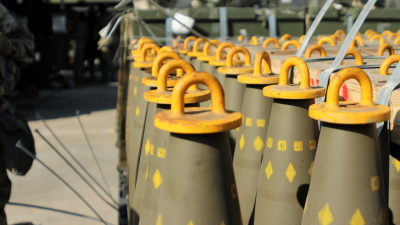Watchdog: Cluster Bomb Deaths in Ukraine Are Highest in the World

All Global Research articles can be read in 51 languages by activating the Translate Website button below the author’s name.
To receive Global Research’s Daily Newsletter (selected articles), click here.
Click the share button above to email/forward this article to your friends and colleagues. Follow us on Instagram and Twitter and subscribe to our Telegram Channel. Feel free to repost and share widely Global Research articles.
***
As the proxy war in Ukraine continues raging, people are being killed and wounded by cluster bombs at a higher rate than anywhere else in the world including Syria, according to the Cluster Munition Coalition.
The coalition – which is a network of non-governmental organizations that support banning the controversial weapons – released an annual report showing 2022 was the deadliest year on record globally for cluster bomb related killings.
Cluster bombs open up in the air and scatter scores of small bomblets and submunitions across large target areas, these often kill non-combatants for decades prior to the conclusion of conflicts where the arms are used. More than 120 countries have signed on to a United Nations convention prohibiting the munitions which kill indiscriminately. However, Washington, Kiev, and Moscow are not signatories.
Both Kiev and Moscow have been firing the weapons during the war. In July, the White House announced the US would be providing Ukrainian forces with cluster bombs, even though evidence already existed that Kiev had used the munitions to kill civilians before and after the Kremlin launched its invasion.
Alex Hiniker, an independent expert with the Forum on the Arms Trade, complained that he and other researchers are “baffled by the fact that [Washington] is sending totally outdated weapons that the majority of the world has banned because they disproportionately kill civilians.”
Over 300 people were killed, and in excess of 600 were wounded, by these bombs in Ukraine last year per the coalition’s report. In Syria, which was until recently the site of the most yearly cluster bomb casualties, saw 15 people killed and 75 wounded. In Iraq, where the US military has used cluster bombs during the Gulf War and the 2003 invasion, 15 people were killed and 25 were wounded.
In Yemen, where Riyadh has used US provided cluster bombs to kill civilians during its genocidal war against northern Yemen’s Houthis, there were five deaths and 90 people wounded by the bomblets last year. In 2022, there were no cluster bomb attacks reported in either Iraq or Yemen.
The primary victims of the unexploded, so-called duds – bomblets which look like metal balls – are children who pick them up to play with them unaware of what they actually are. The submunitions also often shepherds and scrap metal collectors – a not uncommon post-war source of income – explains Laura Persi, an editor of the coalition’s annual report.
During the Vietnam War, US forces dropped hundreds of millions of cluster bomblets on Vietnam, Cambodia, and Laos. People still die in Laos on a yearly basis as a result of the tens of millions of unexploded ordnances left behind after US bombing campaigns.
*
Note to readers: Please click the share button above. Follow us on Instagram and Twitter and subscribe to our Telegram Channel. Feel free to repost and share widely Global Research articles.
Connor Freeman is the assistant editor and a writer at the Libertarian Institute, primarily covering foreign policy. He is a co-host on Conflicts of Interest. His writing has been featured in media outlets such as Antiwar.com and Counterpunch, as well as the Ron Paul Institute for Peace and Prosperity. He has also appeared on Liberty Weekly, Around the Empire, and Parallax Views. You can follow him on Twitter @FreemansMind96
Featured image is from TLI

